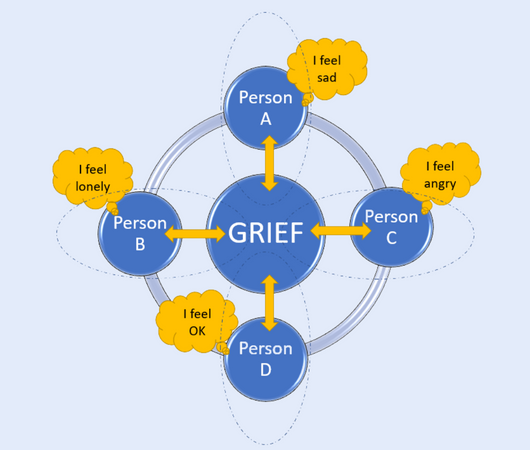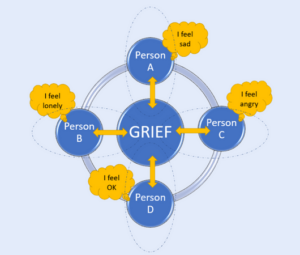5 Tips to Navigate Different Feelings After the Same Loss

Understand the Dynamics of a Grieving Family
When thirteen-year-old Santiago Abut unexpectedly passed away, his heartbroken family found themselves navigating the different ways they each coped. His sister, Caroline, was only five when Santi died. She had dozens of questions and needed information. Santi’s father channeled his emotions into finding grief support resources for his daughters.
Every family who loses someone they love faces this challenge: no two people grieve the same, even when they are grieving the same person. The individuals who make up a family are linked to one another in different ways—as individuals, as pairs, and as groups. Each family member’s reactions may unsettle the family system as a whole. It can be confusing and painful. Here are some tips from our evidence-based Moving Forward program on how to cope with loss within a family.
1. Give your family members permission to feel. Whether you explicitly tell your loved ones that you respect whatever feelings they are having, or you show them through your actions, loss brings up a range of complicated feelings that can make grievers uncomfortable. Anger, guilt, and ambivalence are just some of the emotions that can come up after a loss. While you might feel deep sadness, your spouse might be overwhelmed by rage. There is no right way to feel. The more you can show your loved ones that their emotional experiences are as valid as yours, the more you will all be able to process.
2. Identify your individual fears. Anxiety is often less recognized by mourners, but loss is one of the most vulnerable experiences we can go through. It can manifest in many different types of fear, from a sense of helplessness to concern about what life going forward will look like.
Remember that each individual has a unique combination of fears, especially within families. Identify your specific fears, trying to separate any anxieties you’re feeling from the messages you are getting from other members of your family. Once you hone in on what your particular fears are, seek out the methods of calming your concerns that work for you individually.
3. Create moments your family can cherish together. Do not pressure yourself to force joy and celebration in the midst of your bereavement, but try to spend time together as a family in situations that allow for peace and calm. That may be taking a walk in nature or cooking a comforting meal together. Keep in mind that these activities may bring up many emotions, especially if they are things you used to do with your loved one. Allow yourself to experiment with old ways of memory-making, as well as new.
4. Recognize the choices you do have. Experiencing loss is something entirely out of our control, a challenge we have no choice over. But we do have many choices in how we grieve, and those can help bring a sense of control back to our lives. For example, you might choose between spending time with supportive family and friends, or creating private time alone for reflection. You might find comfort in continuing with familiar routines, or feel drawn to create new habits.
You don’t have a choice in your loss or how your family reacts to it. But you do have agency over how you practice your grief.
5. Acknowledge different reactions and expectations. Have a conversation with your family to acknowledge the differences in what you are each feeling, and include space to talk about your expectations. Are you wanting a type of support that you’re not getting? Family members may not be able to meet your expectations, and you might not be able to meet theirs, but talking through those needs can help prevent feelings of resentment from emerging from the unique experiences of each person in your family.
However you and your family are grieving, know that conflict, confusion, and differences are normal. Give yourself–and your loved ones–time, patience, and room to feel.



